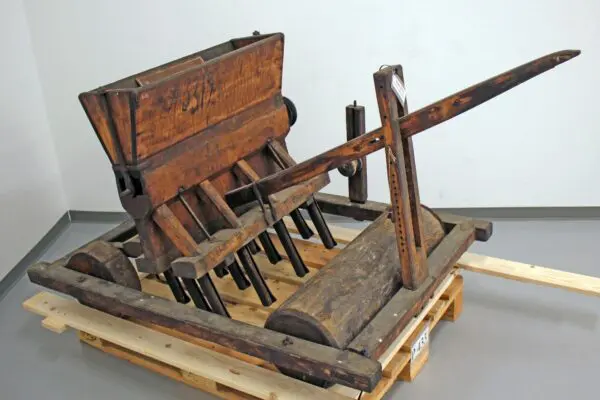Row seeder

Up until sometime in the 19th century, it was normal to throw the seed by hand over the field when sowing in the spring. The seed was placed in a seed basket, a wicker basket that could be easily carried around the field with a strap over the shoulder. The method was easy and quick. But you also lost a lot of seed that way, and you risked that the seed was sown either too densely or too widely.
During the 18th and 19th centuries, attempts were made to construct machines that could gradually sow the seed in even rows and at the right depth. Typically, it was the larger farmers, the nobility and the new agricultural companies that sprang up throughout Europe at that time who took the lead. Among ordinary farmers and servants, attitudes towards the new machines were probably more mixed. There were many traditions and rituals associated with sowing. It was a whole body of knowledge that had been developed over generations. The sower throwing the seed across the field has also been a popular symbol and used as a motif in numerous works of art.
In our collection we have an example of a Norwegian row seeder from the period around the end of the 18th century and the beginning of the 19th century. It was donated to the museum in 1902 by the Norwegian politician Haakon Tveter (1844-1930) on behalf of the Royal Society for the Welfare of Norway, which was a counterpart to the Royal Danish Agricultural Society.
This is a so-called Lomsk seed drill, named after the Lom area in Gudbrandsdalen. The seed was poured into the box at the top, after which it gradually ran down into the seed grooves and deposited in rows in the soil, after which the rear roller pressed the soil together again. The machine had several advantages over sowing by hand. It saved seed, planted in straight rows, which made weeding easier, and the depth could be regulated using the rear rod. It was also light enough to be pulled by a single horse.
The Lomske seed drill was widespread in parts of Norway. In Denmark, however, sowing by hand remained normal until factory-made seed drills made their appearance in the late 19th century. By 1902, the Norwegian model was already obsolete. During the 20th century, seed drills became increasingly larger and more efficient. However, the large tractor-driven seed drill did not achieve the same iconic status as the sower. Today, farmers are able to sow incredibly precisely with the help of IT technology. The knowledge and expertise required to sow has thus changed significantly over the past 200 years.
A reconstruction of the seeder can be seen in use here: https://www.youtube.com/watch?v=6UU88WjZ5Mo
About our items
The Green Museum has around 77,000 objects in our collection, covering the history of agriculture, forestry, hunting and food. Only a small part of our collection is on display at the museum. The rest of the objects are stored so that future generations can also gain an insight into our common cultural heritage.
